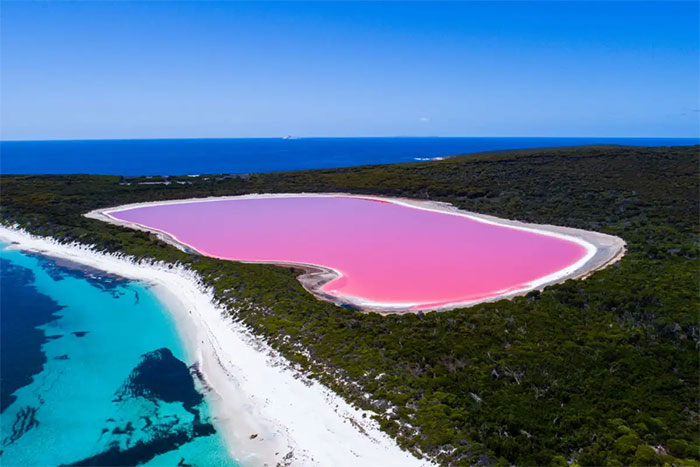Why are there so many pink lakes in Australia?
On an island off the south coast of Western Australia lies a lake called Hillier , which is famous for its beautiful pink color, which looks like a strawberry milkshake. However, experts advise you not to try drinking it, because Lake Hillier is 10 times saltier than ocean water.
Previously, many studies suggested that pink water is due to a salt-loving algae called Dunaliella Salina that lives in the water. Algae contains a pigment called beta carotene, which is also found in carrots. But in 2015, Dr. McGrath, working on the Extreme Microbiome Project, using genome sequencing to study organisms living in extreme environments, discovered something surprising.

In Australia there are many pink lakes.
'We confirmed that D. Salina algae is present in Lake Hillier, but in very low numbers. What we found was a bacteria called Salinibacter Ruber . More than 20% of each DNA fragment we collected from the lake was from bacteria, while less than 0.1% of the DNA collected was from algae ," he said.
The bacteria Salinibacter Ruber contains a pigment called bacterioruberin, which is much pinker than beta carotene.
After his research trip, Dr. McGrath placed a souvenir bottle of water from Lake Hillier on his desk and noticed something remarkable.
There was a window on one side of his desk and after a while he noticed the algae - which have small tails and can wriggle towards sunlight - moving to the side of the bottle that had light.
"But the remaining water is still pink," he said, adding that this is clear evidence that it is bacteria, not algae, that makes Lake Hillier pink.
In Australia there are many pink lakes, but not all lakes maintain their pink color as persistently as Hillier. There is a lake near the center of Melbourne that used to be pink but has now turned dark blue. Parks Victoria expert Martin Watts said a spell of hot, dry weather appeared to turn it pink. 'It is a natural phenomenon that occurs when high temperatures evaporate freshwater components from salt water. The last time it turned pink was April 2019."
According to environmental scientist Tilo Massenbauer, the pink lake is created by a combination of many factors including the climate and hydrology of this old continent such as: increased temperature, high salt concentration in the water, light Sun and little rainfall. Besides, D. Salina algae is green, but in water environments with high salt content and high intensity light such as Lake Hillier, algae need to rely on beta-carotene for photosynthesis, this pigment can change. The resulting algae is red, making the surrounding water pink.
- Special pink lakes
- Australia: Excavating giant pink diamonds
- Mysterious rose lake in Australia
- Pink stingrays were first discovered in Australia
- How to distinguish Vietnamese pink and standard Chinese pink without correction
- Red blood snail is found in Australia
- Really, there is no pink?
- Mysterious giant jellyfish re-exported after more than 100 years
- Things to remember when eating persimmons
- Discovered strange pink elephant in Thailand
- Discover the world's most mysterious pink leopard
- Variety of animals that we know little about
 'Fine laughs' - Scary and painful torture in ancient times
'Fine laughs' - Scary and painful torture in ancient times The sequence of numbers 142857 of the Egyptian pyramids is known as the strangest number in the world - Why?
The sequence of numbers 142857 of the Egyptian pyramids is known as the strangest number in the world - Why? History of the iron
History of the iron What is alum?
What is alum?